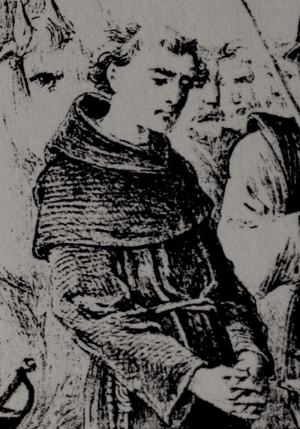Richard Thirkeld facts for kids
Quick facts for kids BlessedRichard Thirkeld |
|
|---|---|

Richard Thirkill, Guarded by the Sheriff and his men (Illustration for the Memoirs of Missionary Priests, 1878)
|
|
| Martyr | |
| Born | Coniscliffe, Durham, England |
| Died | 29 May 1583 York, England |
| Beatified | 29 December 1886 by Pope Leo XIII |
| Feast | 29 May |
Richard Thirkeld was an English Roman Catholic priest who lived in the 1500s. He died on May 29, 1583. He is known as a Catholic martyr, which means he died for his religious beliefs. In 1886, Pope Leo XIII declared him "Blessed," a step towards sainthood in the Catholic Church.
Contents
Richard Thirkeld's Life
Richard Thirkeld was born in a place called Coniscliffe, in Durham, England. He studied at Queen's College, Oxford around 1564 and 1565. Later, he went to Reims, a city in France, where he became a priest on April 18, 1579.
His Work as a Priest
Soon after becoming a priest, Richard Thirkeld returned to England. He worked in or near the city of York. During this time, it was dangerous to be a Catholic priest in England. He helped many Catholic people and even served as a confessor for Margaret Clitheroe, another famous Catholic martyr.
Arrest and Trial
On March 24, 1583, Richard Thirkeld was arrested. This happened while he was visiting Catholic prisoners in a jail called the Kidcote, located on Ouse bridge. When he was caught, he immediately told the officers that he was a priest. He was then taken to the mayor and spent the night at the home of the high sheriff.
The next day, his trial began. He bravely appeared in his priest's robe, called a cassock, which made him look very respected. The main charge against him was that he had "reconciled the Queen's subjects to the Church of Rome." This meant he was accused of convincing people to return to the Catholic Church, which was against the law in England at that time.
Execution and Legacy
Richard Thirkeld was found guilty on May 27 and sentenced to death on May 28. He was executed in York on May 29, 1583. His execution was kept secret because the authorities were worried. They feared that if it were public, many people would gather and protest.
Six of his letters have survived, giving us a glimpse into his thoughts and experiences. These letters were later summarized by a historian named Bede Camm.
See also

